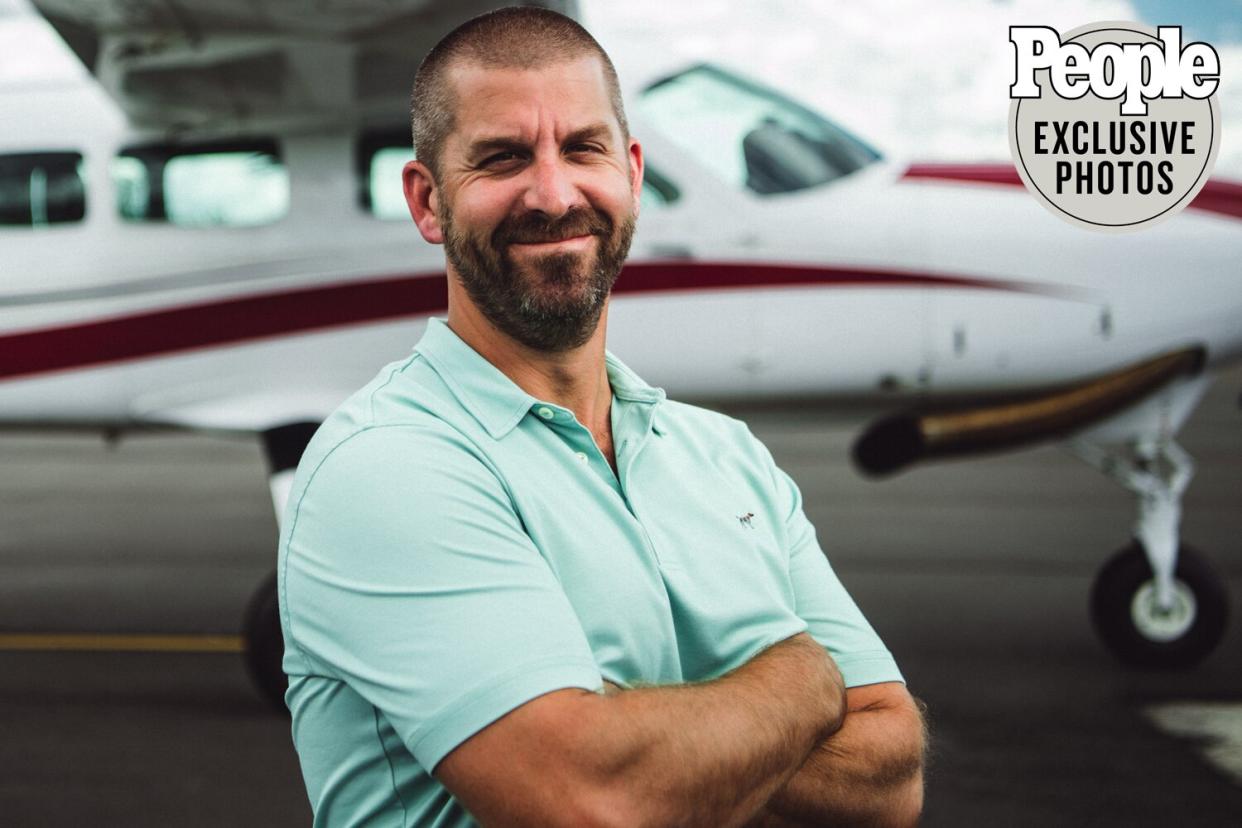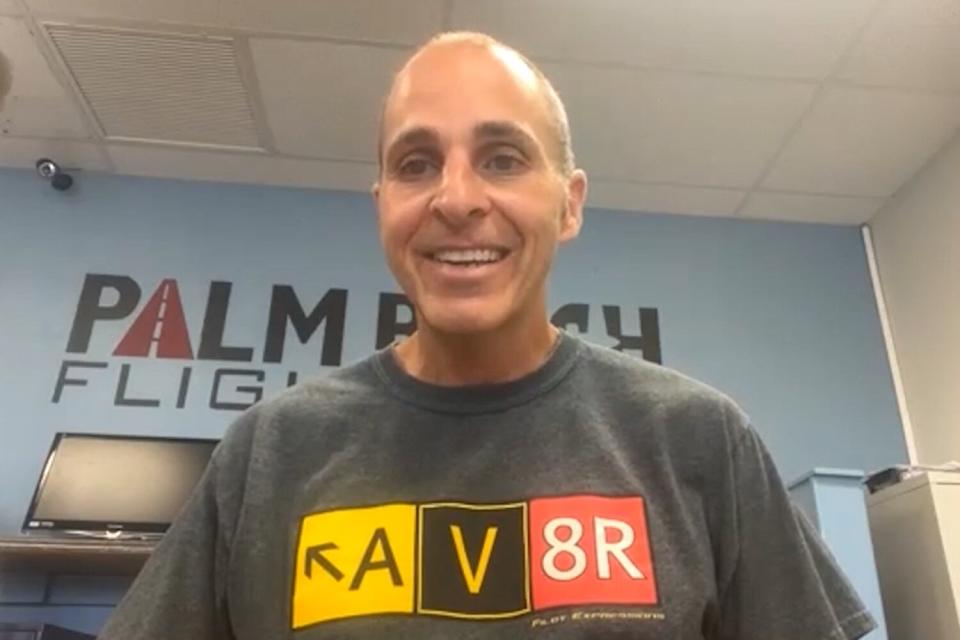Passenger-Turned-Pilot Thought of Pregnant Wife When He Took Over Plane in Emergency: 'I Can't Die Today'

Josh Letchworth
Darren Harrison knew he had only a handful of seconds to live. The pilot of the Cessna 208 he was flying in had just lost consciousness and their plane was plummeting straight toward the blue waters of the Atlantic. As Harrison crouched behind 64-year-old Ken Allen, desperately trying to rouse him, he could see the white caps on the swells below grow larger and larger outside the cockpit windshield.
"I could feel the G-force pushing me back," says Harrison, who had never flown a plane before and stared at the array of levers and knobs on the instrument panel in front of him, trying to figure out how they worked.
"I heard myself think, 'If you don't touch those controls you're going to die in the next twenty seconds,'" he recalls. "My wife is back at home, six months pregnant, and I tell myself, 'I can't die today. This can't happen.'"
A split second later, the mechanically-inclined Harrison—who had peppered pilots of small planes with technical questions during a number of flights—went to work. Reaching over Allen's body, he grabbed what he thought was called "the stick" and gently pulled it back.

Josh Letchworth
"I knew from talking to them [the pilots] that if I yanked it too hard, at the speed we were going, the wings would rip off the plane or the motor would stall," Harrison, 39, says in this week's issue of PEOPLE. "So I slowly, gently pull the stick back and a moment later I remember thinking, 'Wow! We're going up.'"
During the plane's nosedive, they had dropped 3,600 feet in 16 seconds. Harrison kept pulling on the control until the plane reached an altitude of 9,000 feet. And for a brief instant, he could breathe and try to assess the predicament that he found himself in. Little more than an hour had passed since their small, single-engine plane had taken off from Marsh Harbor in the Bahamas. He had spent the past few days fishing with some buddies and was heading back home to Lakeland, Florida, where he runs a flooring and design business with his dad.
After take-off, Harrison kicked off his sandals in the back of the plane and was staring out the window when he heard Allen say, "Guys, I gotta tell you, I don't feel right. I've got a headache, and everything is fuzzy." A moment later, the pilot was unconscious, and the plane began to drop from the sky.
RELATED: Pilot Who Had Medical Emergency Speaks Out After Passenger Landed Plane and Helped Save His Life
As Harrison held the craft at 9,000 feet, he took a deep breath and hatched a plan. The first thing he needed to do was get Allen out of the pilot's seat and lay him down. In the seat beside Allen was Russ Franck, 70, a friend of the veteran pilot, who would often tag along on his flights to keep him company.
"Do you think you can hold us at this altitude?" Harrison recalls asking Franck as he unbuckled Allen's harness and gently pulled him out of the seat. "Watch these numbers on this screen. Don't let 'em go up or down."
He carried the unconscious pilot to the back of the plane, laid him down, and then seconds later climbed into Allen's seat. At the time, he opted not to completely buckle the harness because he was convinced that if the plane crashed and caught fire it would slow down his escape.
For more on Harrison's story, pick up the latest issue of PEOPLE, on newsstands Friday, or subscribe here.
All the display screens were black, except for the gauge that monitors altitude and how level the plane is flying. Harrison had no idea where they were. All he could see was an endless expanse of ocean.
"But screwed onto the dash there was this old school compass and it told me that we were flying due south, instead of northwest, which is the direction we needed to be heading to get to Florida," he says. "I was so disoriented, but I finally turned the plane in the right direction."
With that problem solved, he was suddenly faced with another problem. "I realized nobody else in the world knew what was going on," he says. "'I gotta figure out how to tell somebody,' I thought. But I kept hitting the wrong button on the radio. It took me 20 minutes before I figured out how to get it working."
By then, the Florida coastline was beginning to come into view on the horizon in front of the plane and another realization hit him. "Now I gotta figure out how to land this thing," he recalls telling himself before putting out a call on the radio. "This is Triple Three Lima Delta. I've got a serious situation here. My pilot has gone incoherent. I have no idea how to fly the airplane."
Shortly after Harrison's call went out, Robert Morgan, an air traffic controller at Palm Beach International Airport, who also works as a flight instructor, was in the middle of a break and reading a book when he heard his name over the airport loudspeakers.

FAA
"I remember thinking, 'That's a weird page to get,'" says Morgan, who rushed back to the control tower to learn what was going on. "I walked into the room and my operation supervisor said, 'Here's the situation: 'We've got a plane with an unconscious pilot and the passenger is flying it. Since you're a flight instructor, we need you to try and help him land."
Morgan felt his stomach tense up and says he thought to himself, "I wish this was a dream." But a moment later, he was talking to Harrison, guiding him to the airport. "He told me that he had no idea how to fly a plane, but he didn't sound particularly nervous," says Morgan. "He really seemed like he was going to do whatever it took to save his butt."
Meanwhile, inside the cabin of the Cessna, Harrison was flying north up the Florida coast, using the beach below to navigate his way to the airport. "For the next few minutes, I worked on practicing how to control the altitude by descending a little bit and holding it there, then taking it back up again," he says.
As he got closer to the facility, Morgan instructed him to keep descending because he was still at 2,500 feet. "As I was circling back over the runway to make another approach, I asked him, 'Hey, once I land, how do I stop this thing?'" he recalls. "I was still barefoot at that point and he explained how to gently work the brake pedals with my feet."
The idea of actually trying to set the plane down on the runway in one piece seemed daunting, even for someone who was proving to be as calm and cool under pressure as Harrison. "I pictured the wheels blowing off the plane or flipping upside down into a ditch," he says. Morgan was also concerned. "I was worried, thinking he was either gonna cartwheel down the runway or crash," adds the air traffic controller.
On his second pass, Harrison had the plane lined up with the runway, which was getting larger and larger the closer he got. "Robert told me I was coming in too fast, so I told Russ to grab the throttle [which controls fuel flow to the engine] and dump it on the floor, wondering if that would cause the plane to fall out of the sky," he says.
Then, Morgan told him: "I just want you to focus your eyes on the end of the runway. It's going to get wider and wider."
The next thing Harrison knew, the plane was back on earth, gently bouncing down the runway. "It all worked," says Harrison. "We touched down without blowing the wheels. After we finally stopped, I called up to the control tower again and asked, 'Hey guys, one last question: How do I turn this thing off?'"

FAA
After the engine finally stopped, Harrison pulled his headset off, threw it on the dash and broke down sobbing. "I just lost it," he says. "I started praying this prayer of thanks for letting us land safely. And the biggest prayer of all was for Ken because he was in bad shape."
An instant later, paramedics and airport personnel were swarming around the plane. (Allen, who suffered a tear in his aorta, was rushed to the hospital and has since recovered following surgery.) "The plane didn't have a scratch on it," says Harrison, who hugged Morgan the instant they were introduced. "People say I'm a hero, but I'm not. I'm just a guy who was trying to survive. I realized what I needed to do and I'm convinced God helped my mind go to a place where I could stay calm, focused and get it done. It really was a miracle. Actually, it was one miracle after another that kept us alive."

